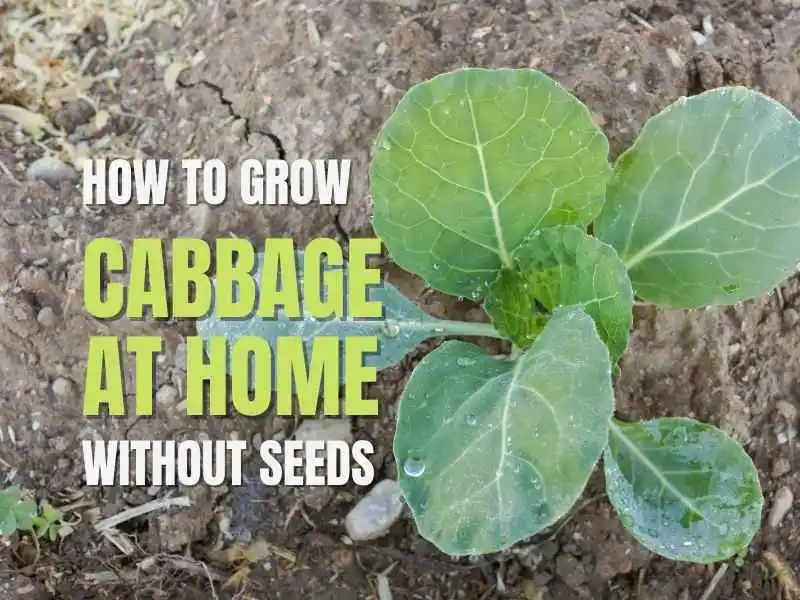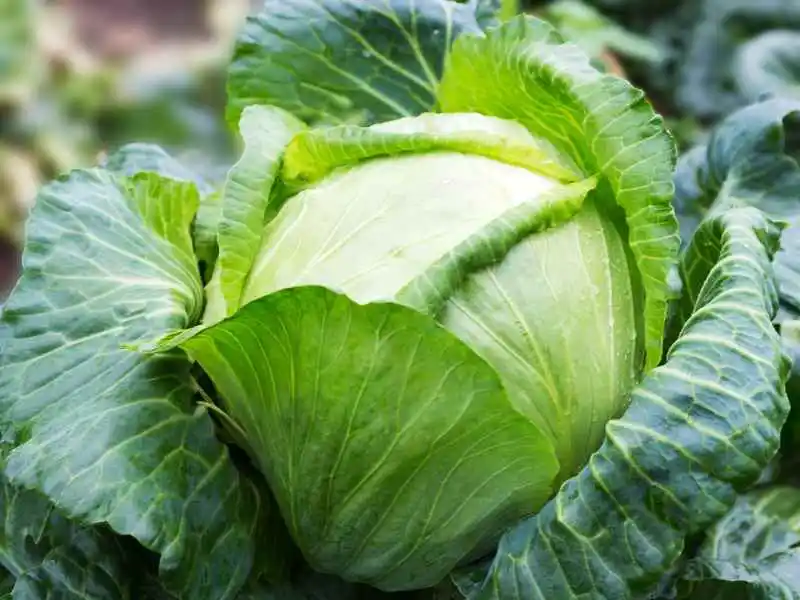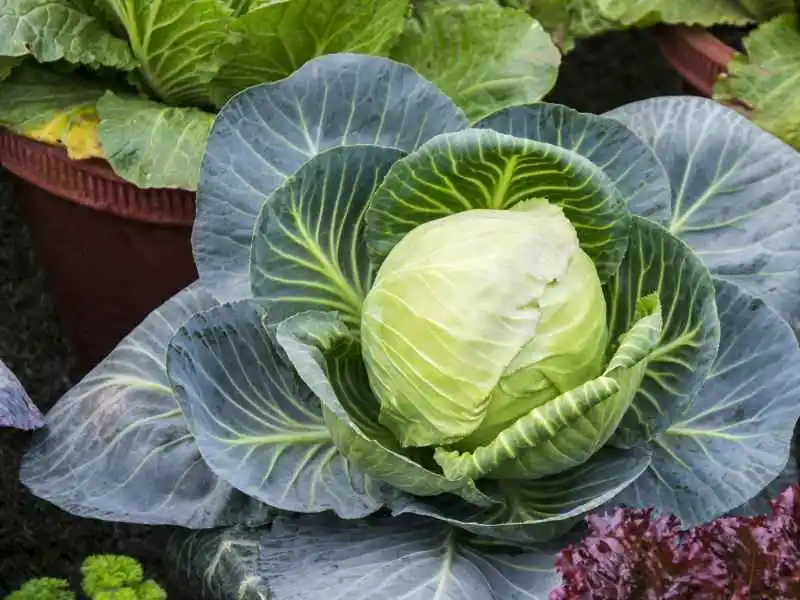Growing cabbage is a very easy and certainly entertaining process. A little care and knowledge would be enough for you to grow it at your home without using any kind of seeds.
In this article, we will discuss a few methods of how to grow cabbage without seeds at home. The first one is growing from scrap.

Plant And Grow Cabbage
Let’s have a detailed look at growing the cabbage plant. As this is a no-seed method, we shall discuss growing it from scrap first, and later we shall look into growing cabbage from young plants or seedlings.
Growing Cabbage From Scraps
It is a commonly used way to start this plant without using seeds. It is the cheapest regrow method because it uses your kitchen scrap.
Here are the steps to keep in mind while you are starting this process of growing a cabbage plant.
Find a good head from cabbage scrap
Firstly, Get a good scrap of cabbage from your kitchen leftovers. Try to pick up the head which has a 2 to 3 inches long stem attached to it. This will be helpful in the good growth of the roots.
Slice the head from the scrap
The next step is to slice the head from the rest of the cabbage scrap. Make sure to leave just a little part of the scraps on the stem. This will help the sprouts to grow.
After this step, you can choose to place it in a water container or you may skip this step and plant it directly into the soil.
Growing Cabbage In Pots
To start growing the head directly in the water, you need to find out the right-sized pot or container. The circumference of the container should be a little less than the size of your scrap. In this way, the scrap can sit on top of the container with the stem facing down towards the water.
Place the cabbage head in a water container
After choosing the right-sized container, fill it with water. This container should help in suspending the cabbage head. Place the head on top of the container with its stem immersed in the water. This will start the growing process.
Put the container in a shady place
Make sure not to put the container in direct sunlight. It should be in a shady place for better results.
Change the water regularly
Keep changing the water timely to ensure the healthy growth of the plant. It should be changed every couple of days.
Plant the cabbage head into the soil
If you don’t want to grow the head in the water, you can just skip this step and place the scrap head directly into the soil. Take the normal garden soil in a container and dig a small hole in it. Place the head on top of the soil and cover it with the soil. Press the head into the soil to remove the air bubble beneath it.
You can use a soil container for it or plant it directly into the ground. Raised bed gardens can also be used for this purpose.
Wait for the leaves to grow
If you are growing cabbage in water, you will observe the roots growing out from the stem. At this stage, you can either transfer it to good garden soil or you can keep it in the water container to grow further.
If you want to transfer it into the soil, make sure that the roots are mature enough to be transplanted.
After some time you will see the cabbage leaves growing from the head.
Cabbage Seedlings | Growing From young plants
If you don’t want to start your plant with kitchen scraps, the second method to grow cabbage without seeds is to get some healthy young plants or seedlings from any online plant shop or a store near you.
Water-Grown Cabbage | Place the young plant into the water
After receiving the young plants, don’t plant them directly into the soil. Put them into the water bucket for some time, at least half an hour, so that they can get properly soaked.
This is important because while transporting the plants they may get dry.
Plant them into the soil
After the plant is ready, dig a deep hole in the soil and plant them into it. Make sure to bury it properly into the soil so that it can get enough nutrients from the soil.
Here are a few more tips and information about growing a cabbage plant at home without seeds.
Growing Cabbage at Home

Cabbage has the scientific name, Brassica oleracea var. Capitata. It is a popular crop and it can be grown anywhere and also has nutritional value because of calcium, phosphorus, vitamin C, K, and B6, fiber, manganese, and potassium. It also has a long storage life.
Soil Preparation
Cabbage is an easy-to-grow plant and it can be grown in different kinds of soils. You can make your soil by mixing potting soil and compost. Use a 2:3 ratio for this mixture. For best results, the soil should be organic-rich and have good drainage.
Soil Testing
Get your soil tested. If recommended, apply potassium and phosphorus to the soil, otherwise, you can just use a low or no-phosphorus fertilizer. The pH level of the soil should range from 6 to 7. Adding lime can increase the pH level of the soil.
Soil Improvement
During the spring or fall season, you can improve your soil by adding compost to it. You can also use well-rotten manure for this purpose. If you are using this method, do not use any other fertilizer then as rotten manure or compost will do the job.
You can also add nitrogen-rich bloodmeal or cottonseed meal into your soil.
Cabbage Growing Season
Cabbage grows well in cool weather. It will not grow properly in temperatures between 45 to 75 degrees Fahrenheit. So plant them accordingly. It grows differently in different regions of the world. It is a spring or fall crop in cold winter areas and a winter crop in areas with mild winters.
If you are transplanting the plant in the garden, do it at least 3 to 4 weeks before the last frost in spring. Plant in late spring in cool summer regions and for mild winter seasons plants them in late summer, about 8 weeks before the first frost.
Enough room for cabbage plants
It needs adequate space to grow properly. They should be placed at least one foot to one and a half feet apart from each other. If you are planting them in rows, there should be a two to three feet distance between each row.
Choosing a container for Cabbage

Growing cabbage in containers is an easy method. Choose a container large enough to ensure proper growth. A 10 to 12-inch wide and deep container or larger would do the job. Your container should contain 4 to 5 gallons of water. Make sure to keep some holes at the bottom of the container.
Watering
Cabbage plants need regular watering. So make sure to keep the soil moist all the time especially when they are in the sunlight. Water evenly with almost 16 to 24 gallons per week. Uneven watering can result in cracked or stunted heads.
Choosing the best location
If you are starting to grow cabbage in water, using your kitchen scrap, then place the container in a shady place. At this stage, it does not require sunlight. Once you see the cabbage leave growing and getting mature enough, it’s time to transplant them into the garden or a container.
At this stage, choose a sunny location for your plant as the growing plant needs proper sunlight for about six to eight hours a day. But it’s better to Harden off your plant.
What is Hardening off?
When your plant needs to be moved outside for its sunlight requirements, do not place them directly for 6 to 8 hours in the sunlight as the plant is not used to it. Use the technique called hardening off. In this process, you have to introduce the plant to direct sunlight gradually. Initially expose the plant to the sunlight for about 2 to 3 hours and then increase the time gradually up to 6 to 8 hours a day.
Note that, do not add fertilizers during the process of hardening off.
Fertilizing
Here are a few tips for adding fertilizers to this plant.
Adding organic fertilizers like a solution of water and Seawood proves good when the cabbage is forming its head. The established plant needs nitrogen-rich fertilizer. Dilute fish emulsion solution is also a good fertilizer.
Avoid using weed-killer fertilizers as they can kill the cabbage plant.
Mulching
Mulching cabbage is a good option, especially when it’s hot weather. This will prove helpful in retaining the moisture level in the soil. This will also help in keeping the pests away from the plant.
Using herbicide-free grass cripplings or any other organic material for mulching also helps prevent weed growth. Add a layer of about 3 to 4 inches of mulch.
Cabbage Companion Plants
Any plant belonging to the brassica family can be a good companion for your cabbage plant. Aromatic herbs can help repel many pests away. Beans, borage, celery, and marigold are also good companions of cabbage.
Cabbage Pests
These plants may attract pests like cabbage worms cutworms, loopers, slugs, aphids, and root maggots. Covering the plant with a floating cover or covering collar helps in saving the plant from pests like cutworms.
Cure the pests
Aphids can simply be removed by washing the plant with a strong stream of water. Loopers and worms can be handpicked and destroyed. Spraying insecticidal soap is also a good option. Planting radishes near cabbages help repel flies and cabbage maggots.
Diseases of Cabbage plant
Cabbage can have fungal diseases like clubroot, yellows, and black rot. Yellowing of the lower leaves of cabbage, wilt, and stunted look of the plant means that it is suffering from fungal disease. Destroy the diseased plant to stop the spread of disease. Using a disease-resistant variety of cabbage can help reduce the risk of fungal diseases.
The cabbage plant can also have purple blotch, black specks, and viral and bacterial diseases. Splitting up the heads of cabbage is a common disease when planting cabbage at home. It is caused by either drought or heavy watering.
Cure the diseases
Increased pH level can counter clubroot and it can be done by adding lime juice to the soil. Do not wet the foliage to counter purple blotch. Commercial and good-quality potting soil can help to avoid viral and bacterial diseases. Increasing potassium levels in the soil help to cure black speak. Mulching helps to cure splitting by retaining the moisture level.
Harvesting the Cabbage plant
Cabbage takes up to 65 to 105 days to fully grow if you are growing it without seeds. Harvest in cool weather. If you are confused about when to harvest, simply just squeeze the cabbage head, if they are firm you can harvest them.
Take a sharp knife and cut the head from the base above the outer leaves. If you want to regrow from the same plant, cut the head 2 to 3 inches above the root and leave some leaves attached to the stem.
Storing the Cabbage harvest
After completing the harvest you can store the cabbage by removing the leaves from it and wrapping it in a damp paper towel. After that place them in a plastic bag and store it in the refrigerator. This method is more effective than directly storing the cabbage in the refrigerator.
Fermentation is also one of the best ways to store the cabbage harvest.
Varieties And Types of Cabbages to be grown
You can try different kinds of cabbage to grow at home. Here are a few best cabbage varieties to grow.
Savvy Cabbage
It has long crinkled leaves and a looser head. It also has a sweet taste and delicate texture.
Brunswick
It has large solid heads and long storage life.
Earliana
This cabbage has the earliest maturing time compared to other varieties.
Golden acre
This is a yellow disease-resistant variety. The plant doesn’t spread much and produces the sweet green heads of a compact plant.
Mammoth red rock
As the name indicates the plant produces up to 8 pounds of cabbage.
How To Grow Cherry Tomatoes From Cherry Tomatoes
How To Grow Sungold Cherry Tomatoes In Containers
References

